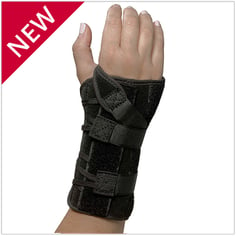Clients with lateral epicondylitis (also known as tennis elbow) consistently appear on my schedule. As therapists, we know that swinging the tennis racket is not the only possible cause of this diagnosis. Lateral epicondylitis is due to a degenerative process at the poorly vascularized origin of the wrist extensors on the boney prominence at the lateral elbow. It is often contributed to over use of the wrist extensors. Individuals with this diagnosis often describe pain at the lateral elbow that is persistent, very uncomfortable and limiting.
Hand therapists have several options to consider in assisting people with the symptoms of lateral epicondylitis to return to pain free use of the involved extremity. Let’s look at some of these options in a little greater detail and in relation to the purpose and evidence on each treatment.
Treatment Options for Lateral Epicondylitis
| Treatment | Purpose | Evidence | |
| Extensor Stretch (Stretch with elbow extension and wrist flexion, also the above with digit flexion) | Provide stretch to the wrist and long digit extensors that are likely tight | Stretching with eccentric strengthening has been found to improve function and pain in individuals with lateral epicondylitis | |
| Education on Posture (avoid lifting with elbow extended and palm down) | Use improved posture to avoid over use and/or loading of the wrist extensors | More research is needed on the isolated use of structured patient education, but education is a common component of multimodal treatment programs | |
| Wrist Brace | Decrease use and loading of the wrist extensors by immobilizing the wrist | Prospective cohort study found that pain, function, and grip strength improved when a wrist brace was used for 1-3 months | |
| Elbow Strap |
|
A crossover randomized controlled trial found immediate increase in pain free grip with use of a counterforce brace | |
| Proximal Stabilization | Strengthening the proximal musculature of the shoulder to allow increased use of big proximal muscles (as opposed to wrist extensors) during function |
|
|
| Eccentric Strengthening |
Attempts to slow down the elongation of the muscle process to assist with strengthening and muscle repair |
|
When I treat an individual with lateral epicondylitis, I often recommend a combination of the above interventions. I recommend a wrist brace for night during sleep to decrease contraction and prolonged stretch of the wrist extensors overnight. The Choice Wrist Brace is a great option for this purpose.
I also often recommend an elbow strap or counterforce brace during everyday functional use of the involved arm, as both a less bulky source of comfort and a tactile reminder to avoid loading the wrist extensors. The 3pp Elbow POP Splint decreases the amount of circumferential squeeze to the forearm to avoid pressure on the radial nerve and allow placement of the pressure to the painful tendon area.
3pp® Elbow POP™ Splint
 For more information on the 3pp Elbow POP Splint click on the button below
For more information on the 3pp Elbow POP Splint click on the button below
Blog References: For more information on this topic, click to see the references for this blog post







